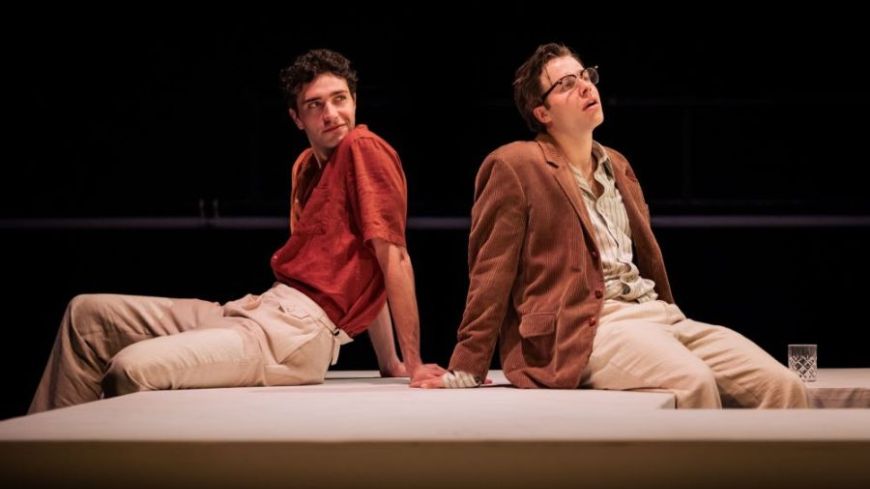
“Do you ever have the feeling you’re being watched?” is a constant refrain uttered by Tom Ripley, directly questioning the audience.
From the first line of ‘The Talented Mr. Ripley’ by Patricia Highsmith, we delve head first into the hard-boiled style of ‘film noir’ intrigue, shady bars and mysterious characters.
‘Tom glanced behind him and walked faster. There was no doubt the man was after him. He didn't look like a policeman or a detective at all. He looked like a businessman, somebody's father, well-dressed, well-fed, greying at the temples an air of uncertainty about him.’
Tom’s feeling of paranoia is embodied by a group of faceless men, hiding behind the wide brim of their Fedora hats, as they lurk in the shadows. Perhaps a figment of his imagination. Ripley is a loner, an outsider, struggling to make a living in New York City, but under his boyish, innocent demeanour, he is a deceitful, scheming, scamming, con artist. No wonder he is anxious that the police are on his tail.
In fact, the well-dressed businessman watching him in the bar is a wealthy shipping magnate Herbert Greenleaf. Believing that his wayward son, Dickie is a friend of Tom, Herbert proposes an all-expenses trip to travel to Italy to find Dickie and persuade him to return home to work in the family business. The consummate fraudster, Ripley quickly gains Mr Greenleaf's trust and the deal is done.
Celebrating its 70th birthday, this classic 1955, psychological thriller, on themes of deception and deadly ambition, is perhaps best known from the gripping, glamorous film starring Matt Damon, and more recently, Andrew Scott in the Netflix series.
The stage set is a rather empty warehouse of a space featuring a central white platform as scenes shift between bars, villa, beach, city apartments, hotel room, car, bus and motor boat. With a simple costume change, stripping off his chinos down to his boxer shorts, Ripley arrives in Mongibello (a fictional Positano) on the Amalfi Coast; here he finds Dickie living with his girlfriend Marge, a writer, and with icy-cool confidence manages to immerse himself into their leisurely, languid world of wealth and freedom.
While Dickie is wary at first, he and Marge are then drawn to this quietly mannered American who is quick to treat them to cocktails and dinner at his hotel. Tom becomes intensely jealous of Dickie, (played with laid-back, enigmatic charm by Bruce Herbelin-Earle), who soon resents his obsessive nature and dependence on him. As a perfect example of a sociopath, Ripley cannot accept rejection of his friendship and responds with vicious retaliation.
‘Better to be a fake somebody than a real nobody’ becomes Tom’s mantra as he now pursues a new life based impersonation, lies and deceit. In a subtle performance, Ed McVey simply removes his glasses, adjusts the tone of his voice, switching character in a instant.
As the action flows between Naples, Rome, San Remo and Venice, the flyer for the show, describes the setting as ‘the sun-drenched glamour of 1950s Italy, surrounded by shimmering waters and whispered secrets.’
Unfortunately, the minimalist dark staging is devoid of any realistic atmosphere, the colourful period or place with no hint of Italian seascapes under the summer sun. The drama is occasionally interrupted by a sudden shout of ‘Cut - Reset’ with a glaring flash of spotlights. Totally confusing at first, these are Ripley’s alternative, sliding door scenarios as he makes split-second decisions to keep up his façade.
Dickie’s friend Freddie quickly detects that something is wrong so Tom has to swat him away like a pesky fly, while detectives swarm around like buzzing mosquitos ready to bite.
The director Mark Leipacher follows the literary, film noir text of Highsmith’s novel to heart. The opening artistic scene in a New York bar is pure Hopper – think of his moody 1940s painting ‘Nighthawks,’ set in a diner. The third person narrative captures Tom Ripley’s internalised thought-process which is succinctly translated from page to stage.
Ed McVey quietly portrays a Macbeth-like figure in his ruthless desire for power and success. He often turns to the audience in a conspiratorial manner, sharing his fears and doubts in a soliloquy, peppered with sardonic dry humour to gain our sympathy as the anti-hero. Catch me if you can!.
A clever theatrical device in the second act is for both Bruce Herbelin-Earle and Ed McVey to both play Dickie simultaneously, as if his ghost, like Banquo, has returned to haunt Tom.
This very stylised, choreographed adaptation may certainly disappoint those who expect the fashionable elegance and sunlit Italian resorts epitomised in the 1999 movie.
Instead, the novel is played out in cinematic close-up focusing almost exclusively on Tom Ripley, to explore the dark, devious mind of a serial killer, akin to a black and white Hitchcock crime thriller. This is a painterly portrait of the narcissistic but very talented Mr Ripley, - intelligent, quick-witted and forever watchful.
Dickie Greenleaf: Everybody should have one talent, what's yours.
Tom Ripley: Forging signatures, telling lies... impersonating practically anybody.
Dickie: That's three, nobody should have more than one talent.
Show times:
16 to 20 September 2025 at 7.30pm. Matinees 18 and 20 at 2.30pm (18 Captioned – 7.30pm. 20 Audio Described and BSL Interpreted).
Tickets: £22.50 to £46.50 (Discounts available).
Suitability:12+ (Note – show contains strong language and scenes some younger audiences might find disturbing).
https://www.capitaltheatres.com/shows/the-talented-mr-ripley/#details

